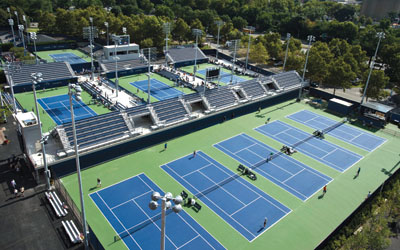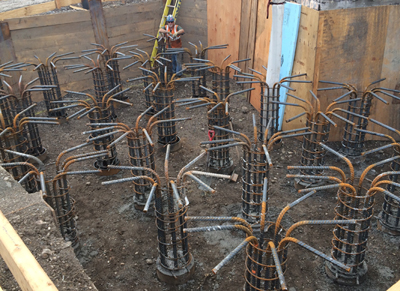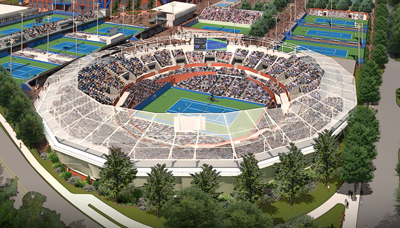In-Depth
Staying on schedule
The first phase of the USTA Billie Jean King National Tennis Center’s $500 million renovation is complete. Design firm Rossetti is overseeing the project and Hunt Construction Group is managing the construction. Below is the timeline for the project.
2014
■ Three new practice courts and three competition courts, with bleacher seating for 1,300 fans sandwiched between
 |
New competition and practice courts opening this year feature improved seating for spectators.
Photo by: USTA |
them, are ready for this year’s U.S. Open. It is the first time the practice courts have had a significant amount of seating. Fans can switch easily between practice and competition, an area the U.S. Tennis Association expects to quickly become a hot spot on the grounds. New video boards are also up atop Arthur Ashe Stadium.
Ongoing work provides the first visible evidence of the long-awaited roof over Arthur Ashe Stadium. Six out of eight cement cappings (looking like enormous flower pots with no bottom) that will circle the stadium are in place.
The pillars to hold up the roof will slide into the caps. One cement capping has taken out the outdoor seating area for Mojitos, an exclusive restaurant on the grounds. Underneath the caps, a labyrinth of wire and steel cables will be filled with cement to hold the pillars in place.
For lovers of the current National Tennis Center, lap up this year’s tournament; next annum’s event will look very different.
2015
 |
Crews are building the bases that will support the roof at Arthur Ashe Stadium.
Photo by: USTA |
■ Pillars will ring Arthur Ashe Stadium, with supporting structures in place, but no roof yet. However, to accommodate the growing covering, the current lights atop the stadium will come down, and temporary lights will be built on a catwalk that will ring the upper tier of the venue.
Construction on a new 8,000-seat Grandstand court (the No. 3 court) will be underway in the southwestern corner of the grounds, the opposite of the court’s current northeastern location.
After the 2015 event, the south perimeter will be extended slightly into the adjacent park. The courts that sit up against the south side will move farther south then. This will allow the walkway on the northern edge of these courts to be expanded from 7 to 40 feet, creating a new thoroughfare for fans.
2016
■ Two decades after Arthur Ashe Stadium opened, it will have a roof, which of course likely means rain will stop
 |
The new Grandstand court will be ready in time for the 2016 event and will have seating for 8,000 spectators.
Photo by: Rosetti / USTA |
for several years. The cost for the roof is estimated to top $100 million.
The new Grandstand court will be completed and will be in use. The old Grandstand court will remain standing but will not be in use.
The new walkway connecting Court 17 to the Grandstand court will be finished. The 40-foot-wide walkway is designed to open up the grounds and reduce crowding.
Between the 2016 and 2017 events
■ Two fan favorites will be torn down: Louis Armstrong Stadium and the connected Grandstand court. Louis Armstrong Stadium, built in 1964, was the main court before Arthur Ashe Stadium and remains popular for the seats’ proximity to the players.
2017
■ The old Grandstand court will be gone, as will be the old Louis Armstrong Stadium. The new Louis Armstrong Stadium will not yet be complete. The lower bowl and court will be finished, and temporary seating also will be available. The exact number of seats, though, is still not determined.
2018
■ The entire project will be complete. The new 15,000-seat Louis Armstrong Stadium will open for business. It will not have a roof (despite circulated renderings showing a roof on the new stadium), though the USTA is describing it as roof ready. That means if the group later chooses to install a roof, the cost and task will be far less onerous than it was to build the one over Arthur Ashe Stadium.






